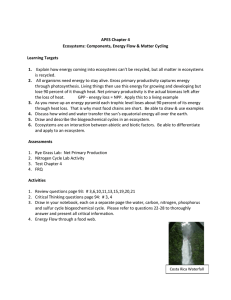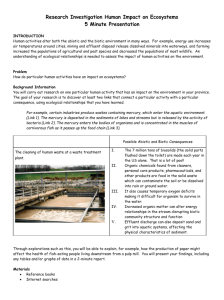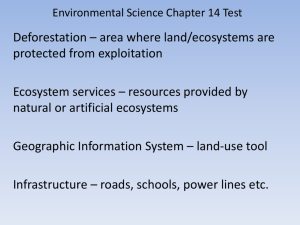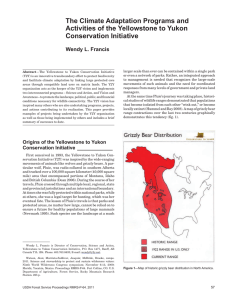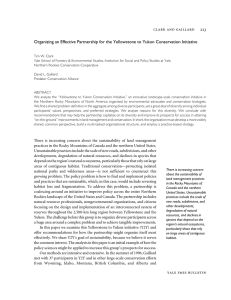Marilyn Averill: Law and Adaptation in Yellowstone National Park
advertisement
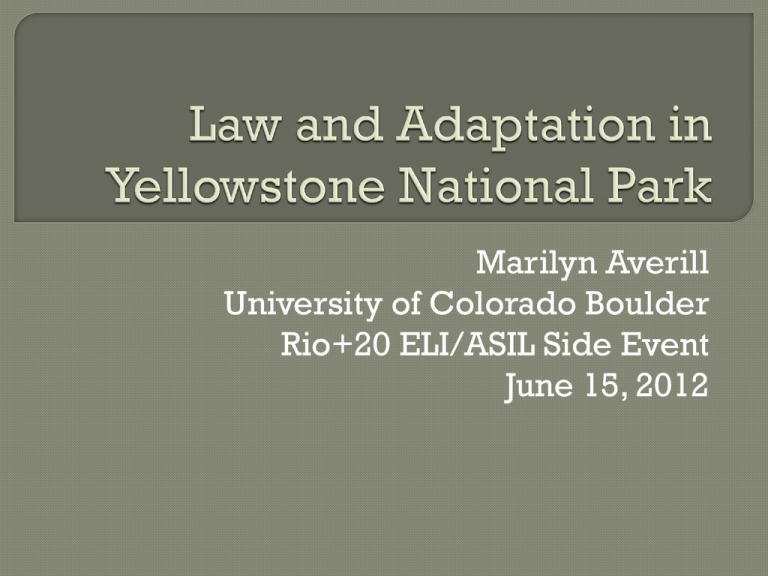
Marilyn Averill University of Colorado Boulder Rio+20 ELI/ASIL Side Event June 15, 2012 Natural areas managed by humans Protects natural areas from some human activities, but also preserves them for human uses Can be public or private This presentation focuses on lands and waters in a protected area owned and managed by the U.S. government Re-emphasizes existing challenges May produce challenges outside of known conditions • • • • • Temperature and precipitation Extreme weather events Shifts in timing Invasive species Sea rise Provides new context and incentive for re-examination of existing law and practices To prevent change? To ease transitions? To protect vulnerable species or areas of interest? To interpret the changes that occur? To protect human uses? “FOR THE BENEFIT AND ENJOYMENT OF THE PEOPLE” Wolves in Yellowstone Nps.gov What is the Park mission? What needs to be regulated • To protect the park? • To achieve other goals? Who should be involved in different decisions? Ensure that Park goals are achieved Protect specific resources Control uses of the Park Mandate procedures Establish rights of use Prohibit activities What was the purpose for which the area was set aside? How will changing conditions affect missions? • Will priorities shift? • Will new stresses change the resource? • Will demands on and uses of the resource change? Should the mission itself be modified? How can and should law adapt to changing values and conditions? Nutrients Hydrograph Species Habitat Fuel Sources Water Quality Timber Water Quantity Recreation Hiking Mining Hunting Regional security Carbon Sink Camping Outfitting Native species Views Ecosystems Spiritual sites Cultural artifacts Snowmobiling Ecosystems Wilderness Tourist Services Beaches Fishing Wildlife Food sources Livelihoods Air Quality “which purpose is to conserve the scenery and the natural and historic objects and the wild life therein and to provide for the enjoyment of the same in such manner and by such means as will leave them unimpaired for the enjoyment of future generations.” Sought to preserve matchless natural wonders from “settlement, occupancy, or sale,” as well as “from injury or spoliation,” and to retain these same wonders “in their natural condition.” The park was to be a “pleasuring-ground for the benefit and enjoyment of the people.” Who should be involved? At what stages and for what purposes? How will their voices be heard? Legal rights Moral rights Political interests Who will speak for nature? For the powerless? For those who lack capacity? “I speak for the trees, for the trees have no tongues.” Law can ensure that some voices are heard • National Environmental Policy Act (NEPA), Endangered Species Act (ESA), Law can also restrict participation • Federal Advisory Committee Act (FACA), NEPA,ESA The same laws that demand participation by some parties can restrict participation by others Resource management should consider: • Embededness • Connectivity Embededness and connectivity further complicate the legal landscape Protected areas are situated within a larger natural and human context that must be considered in making management decisions What is the nature of the surrounding human and natural community? How will changing conditions affect the impacts surrounding communities have on the resource? How will changing conditions impact the way the resource influences the surrounding area? Connections to other areas can have important effects on a protected area What links the protected area to other areas? • What links it to human communities and human activities? • What links it to other natural areas? • What links give access to threats? • What links are important to maintain ecosystems? How are needs of humans and nature affected by current connections? How will changes affect these connections? We envision a day when the human and wild communities of the Yellowstone to Yukon region coexist in a way that allows each to thrive. Without a unified vision for this deeply interconnected landscape, local conservation efforts may be isolated and less effective. One of Y2Y's primary goals is to ensure that the Yellowstone to Yukon region retains enough connected, well-managed and good-quality wildlife habitat so that animals can safely travel between protected areas…. as they roam in search of food and mates. • Y2y.net International • Treaties • Agreements with Canada • Canadian law Federal State • Wyoming • Montana • Idaho Local Wildlife Mining Water quality Commercial regulation Property rights Visitor use Visibility Transportation Recreation Livestock disease control Water rights Health and Safety Taxation Road maintenance Indigenous Knowledge Pastoralists Engineers Economists Botanists Veterinarians Geologists Wildlife Biologists Historians Animal Control Hydrologists Chemists Soil Scientists Anthropologists Silvaculturists Lawyers Fluvial Geomorphologists Human management affects natural resources Climate change will affect both human and natural systems Need legal and other management systems that are resilient to political and economic shocks, as well as to climate change Resilient with respect to what? • Any change? • Change that affects human appreciation and uses? • Change that affects ecosystems? • Political changes? • Economic changes? • Institutional changes? How can law improve resilience of the protected area and its adaptation to changing conditions? Changing conditions will affect • Climate • Wildlife • Ecosystems • Humans • Relationship between humans and nature Laws are needed that will ease transitions Relevant to current and changing conditions Able to respond to change Promote adaptive management • Provide protection • Allow experimentation Climate change is an experiment in itself Responses will have unanticipated outcomes Adaptive management demands experimentation to promote learning Experimentation entails risks How much risk should be tolerated? • To what resources? • Who should decide? How can law be both protective and flexible? How should a legal framework be judged? • • • • • • • • Protection of species? Protection of ecosystems? Prevention of change? Ability to handle transitions? Maintenance of human uses? Public involvement? Public acceptance? Achievement of objectives?


